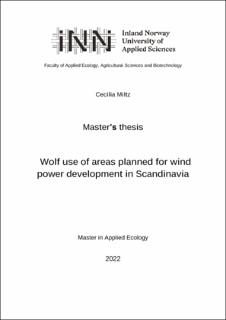| dc.description.abstract | The global energy demand is increasing, and the world is shifting towards using more renewable energy. As a result, onshore wind power development is increasing, though little is known about effects of wind power development on terrestrial mammals. This results in information about effects of wind power development on wildlife often not being included in environmental impact assessments (EIA), when planning new wind power plants. In Norway and Sweden, the wolf (Canis lupus) distribution is partly overlapping with sites chosen for wind power development, but to my knowledge no studies on the effects of wind power development on wolves in Scandinavia have so far been done. A monitoring programme in Portugal has shown that wolves were influenced by wind power development especially during the construction phase, wherefore it could be assumed that this is applicable in this study area too. Using GPS and VHF positions (wolf pair level: n = 56335; individual level: n = 17859) of wolves (wolf pair level: n = 58; individual level: n = 38) in Norway and Sweden, I investigated if there is the potential for wind power development to influence wolf area use by using wolf space use data from before the construction. This was done by looking at overlap of proposed and established wind power plants, consisting of one or several clusters of wind turbines, with wolf territories on the landscape level and on a finer scale in the immediate surroundings of the wind turbines. Since wolf pairs travel together most of the year, except during the denning season, I analysed observations on two levels: as individuals during the denning season and in wolf pairs for the remainder of the year. My results indicate that on the wolf pair level the highest overlap is found during the denning season, followed by the rendezvous season, early winter and least in late winter. The same pattern was found for the probability of individual wind turbines being placed in the wolf activity centre. However, the proportion of areal overlap between wind power plants and the wolf activity centre were rather low on both the wolf pair level (mean: 0.02; range: 0.00 - 0.56; 95% CI [0.01; 0.02]) and the individual level (mean: 0.05; range: 0.00 - 0.61; 95% CI [0.01; 0.08]). On the individual level, sex, reproductive status, and time of day were affecting both the wolf usage index and probability of individual wind turbines being placed in the wolf activity centre. The wolf usage index at turbine sites for non-breeding wolves (mean: 0.31; range: 0.00 - 0.99; 95% CI [0.29, 0.33]) was higher compared to breeding wolves (mean: 0.21; range: 0.00 - 0.99; 95% CI [0.19, 0.21]). The probability of individual wind turbines being placed in the activity centre was low and no large differences between reproductive statuses and sex were found. These findings are in accordance with previous findings, that wolves are most vulnerable to wind power development during the denning season. However, my findings indicate that wolf family groups might be vulnerable to wind power development also during the rendezvous and early winter season. To verify the findings of my study, quasi-experimental studies with a Before-After-Control-Impact (BACI) design on radio-collared wolves could be used. If this verifies my findings, the here used approach could be a more time- and cost-effective way than BACI studies to provide information for EIAs in the future. | en_US |
